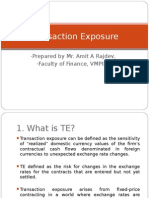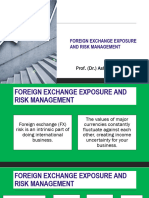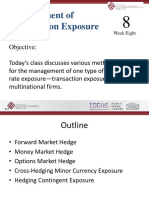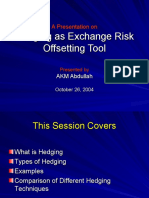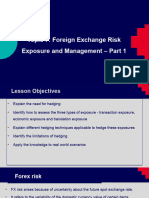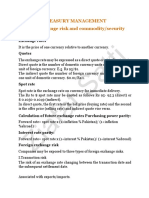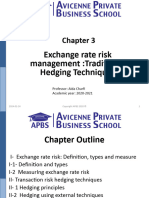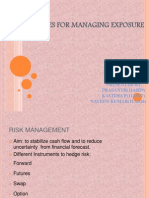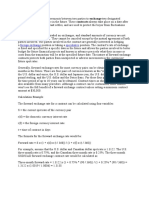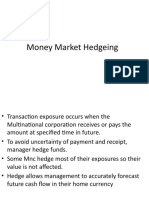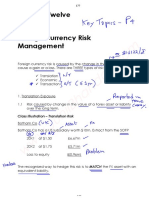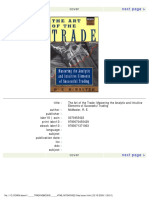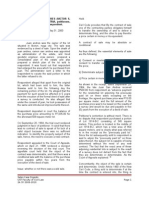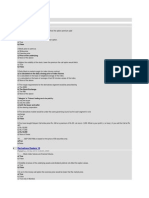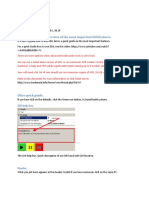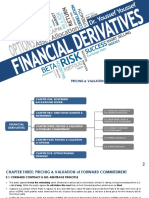8/24/24, 1:24 AM Section | 17.
3 Foreign Currency Risk Management | ACCA Study Hub
External Techniques
Transaction risk can be managed using a variety of external hedges, including:
Forward exchange contracts;
Money market hedges;
Currency options;
Currency futures contracts;
Currency swaps.
3.2.1 Forward Exchange Contracts
A forward contract is a legally binding agreement to buy or sell:
a specified quantity;
of a specified currency;
on an agreed future date ("delivery date");
at an exchange rate fixed today.
Forward contracts are not traded but agreements between a company and a counterparty (e.g. a bank).
They are customised to match the company's exact requirements regarding quantity and delivery date.
Forward contracts are not bought; they are entered into. There is no premium to be paid to set up a forward
hedge (unlike options).
Forward contracts do not require any margin to be posted (i.e. no cash deposit is needed when setting up a
forward hedge, unlike futures contracts). However, there will usually be a small arrangement fee to set up a
forward contract. Also, where the counterparty is a bank, the bank will assess the customer's
creditworthiness.
The major disadvantage of forward contracts is that physical delivery must occur. So, a company
signing a forward contract to buy/sell foreign currency must physically exchange currency on the
agreed date at the agreed rate, even if that rate has become unattractive compared to the spot rate.
Therefore, forward contracts are not a flexible method of hedging.
Example 2 How Exchange Rates are Quoted
A pair of rates is quoted for each spot and forward. For example:
Spot € per $ 1.2022−1.2028
Three-month forward rate € per $ 1.2014−1.2026
One of each pair is used to change dollars ($) to euros (€). So $100 would buy €120.22 now (or €120.14
in three months). It must be the rate which gives the lower amount.
https://studymaterials.accaglobal.com/app/financial-management-fm-for-exams-from-september-2024-june-2025#read/section/1732-external-techniqu… 1/8
�8/24/24, 1:24 AM Section | 17.3 Foreign Currency Risk Management | ACCA Study Hub
Example 2 How Exchange Rates are Quoted
The other amount in each pair is the rate for selling €s in exchange for $s. €120.28 would buy $100 now,
and €120.26 would be $100 in three months. In other words:
Buy (€s for $s) Sell
Spot € per $ 1.2028 1.2022
Three-month forward rate € per $ 1.2026 1.2014
Example 3 Forward Exchange Contract
Lucca Co, a manufacturer in Italy, exports to the US. It has agreed to a $500,000 sale, to be received in
three months, and wants to hedge against (i.e. reduce the risk of) currency movements. (Assume the
rates in Example 2.)
Lucca Co will want to change $s received in three months to €. It can enter into a binding agreement with
a bank to deliver $500,000 to the bank in three months in return for €600,700 ($500,000 × 1.2014). That
rate and the € amount Lucca Co will receive is now guaranteed, irrespective of the spot rate in three
months.
What happens if the sale falls through after arranging the forward contract? (This does not necessarily
mean a bad debt; the order might be cancelled and the goods not sent.) As the contract is binding, the
bank will expect Lucca Co’s commitment to be fulfilled. Lucca Co will need sufficient € to buy $500,000 at
the spot rate in three months. Lucca Co could make a loss or gain on this “closing out” of the contract,
depending on the spot rate at that time.
Activity 3 Hedging with a Forward
Today is 1 January 20X1. A UK-based company expects to receive dividend income of $200,000 from
its US subsidiary on 31 March 20X1.
Spot rate 1 January 20X1 ($ per £) = 1.5123−1.5245
Three-month forward = 1.5323−1.5459
Required:
Calculate how much sterling will be received a if forward contract is entered into.
Calculate how much sterling would be received without a forward contract if the actual spot
rate on 31 March 20X1 is 1.5247−1.5361.
*Please use the notes feature in the toolbar to help formulate your answer
https://studymaterials.accaglobal.com/app/financial-management-fm-for-exams-from-september-2024-june-2025#read/section/1732-external-techniqu… 2/8
�8/24/24, 1:24 AM Section | 17.3 Foreign Currency Risk Management | ACCA Study Hub
(a) Sterling received with forward contract
$s, the variable currency, will be received, so must be sold forward. £s, the base currency, are being
bought in the forward market.
Forward rate for changing $ into £ is 1.5459. Therefore:
£ receipt = = £129,374
(b) Sterling received with no forward contract
Actual spot for changing $ into £ is 1.5361. Therefore:
£ receipt = = £130,200
Exam advice
Calculations will only be required on forwards and money market hedges. The more complex derivatives
(options, futures and swaps) can only be examined by discussion.
3.2.2 Money Market Hedges
Definition
Money market hedge – a technique to lock in the value of a foreign currency transaction in terms of the
organisation's domestic currency using a combination of investing, borrowing and a spot currency
exchange.
Suppose a UK company has dollar export earnings. A money market hedge could be set up as follows:
1. Borrow dollars today at the company's fixed-rate dollar borrowing rate, for repayment when the dollar
earnings are due to be received. The intention is that the dollar earnings will repay this dollar loan.
2. Exchange these dollars into sterling at the current spot rate.
3. Invest the sterling received at the company's fixed rate sterling investment rate, to mature on the date
the dollar earnings are due.
A money market hedge effectively produces a "homemade" forward exchange rate. The resulting exchange
rate depends on the interest rate differential between the two currencies.
Example 4 Money Market Hedge
Lucky Co, a UK manufacturer, exports to the US and will receive $2m in three months. There would be no
currency risk if the $2m could be used to settle a $2m liability, as the currency inflow and outflow would
match.
If Lucky Co does not have a $2m liability to settle, it can create one by borrowing $ now and repaying the
loan in three months with the $ receipt. So the plan is:
2021_FM_ST_Ch17_v1_Pg_317_img003.png
https://studymaterials.accaglobal.com/app/financial-management-fm-for-exams-from-september-2024-june-2025#read/section/1732-external-techniqu… 3/8
�8/24/24, 1:24 AM Section | 17.3 Foreign Currency Risk Management | ACCA Study Hub
Example 4 Money Market Hedge
To determine how many $s need to be borrowed now, it is necessary to know $ interest rates. For
example, the $ three-month interest rate might be quoted as 0.54% – 0.66%. The lower rate is the rate
earned for money on deposit; the higher rate is the rate charged on borrowing.
Key Point
Although described as a “three-month” rate, it is always quoted as an annualised rate; therefore, it
must be restated as a rate applicable for the period in question.
The $s borrowed now plus interest accrued at 0.66% (per year) for three months need to equal $2m. So,
If X is borrowed now:
X(1 + (0.66% × 3/12)) = 2,000,000
Therefore, X = $1,996,705
This can be exchanged for £s now, at the current spot rate, say at $ per £, 1.4701 = £1,358,210.
This amount is certain regardless of what happens to the exchange rate in the future.
Example 4 hedges a receipt of foreign currency in the future. If foreign currency has to be paid in the future,
the company would change money into foreign currency now and put it on deposit to grow to the required
amount by the right time. Again, because the money is changed now at the spot rate, the transaction is
immune to future changes in the exchange rate.
Example 5 Money Market Hedge v Forward Contract
Why might the somewhat complicated money market hedge process (Example 4) be used instead of a
simple forward contract (Example 3)?
One advantage is that Lucky Co has money now, whereas Lucca Co has to wait three months for it.
Lucca Co can use the money now – or at least put it in a £ deposit account for three months. This raises
an important issue –if amounts are received at different times, they cannot be compared directly because
receiving money earlier is better than receiving it later.
To make a meaningful comparison, calculate the future value of the amount received now and deposited
for three months. For example, if the sterling three-month deposit rate is 1.2%, £1,358,210 put on deposit
for three months gives £1,362,285 (1,358,210 × (1 + (1.2% × 3/12)).
Activity 4 Money Market Hedge
https://studymaterials.accaglobal.com/app/financial-management-fm-for-exams-from-september-2024-june-2025#read/section/1732-external-techniqu… 4/8
�8/24/24, 1:24 AM Section | 17.3 Foreign Currency Risk Management | ACCA Study Hub
A UK-based company expects to receive $300,000 in three months.
Spot rate ($ per £): 1.7818−1.7822
One-year sterling interest rates: 4.9%(borrowing), 4.6% (investing)
One-year dollar interest rate: 5.4% (borrowing), 5.1% (investing)
Required:
Set up a money market hedge.
*Please use the notes feature in the toolbar to help formulate your answer
Expected receipt after 3 months = $300,000
Dollar fixed-rate interest rate over 3 months = 5.4% x 3/12 = 1.35%
Dollars to borrow now to have $300,000 liability after 3 months = $300,000/1.0135 = $296,004
Spot rate for selling dollars = $1.7822 per £
Sterling deposit from borrowed dollars = $296,004/$1.7822 = £166,089
Sterling interest rate over 3 months = 4.6% x 3/12 = 1.15%
Value in 3 months of sterling deposit = £166,089 x 1.0115 = £167,999
3.2.3 Currency Options
A company may consider buying a currency option if it wants a more flexible hedge. Options are an
example of derivatives (i.e. a financial instrument based on an underlying asset). In the case of currency
options, the underlying asset is a currency.
The purchaser of a currency option has the right, but not the obligation, to buy or sell:
a specified quantity;
of a specified currency;
on or before a specified date (expiry date);
at an exchange rate agreed today (exercise price/strike price).
The owner of the option can either:
exercise their right; or
allow it to lapse (i.e. not exercise it).
However, the owner of an option must pay for this flexibility. The cost of an option is known as its premium.
Premiums are paid at the date the option is bought and are non-refundable.
A company may buy options:
on a derivatives market; or
directly from a bank − known as OTC ("over-the-counter").
Key Point
A call option gives its owner the right to buy the underlying asset.
https://studymaterials.accaglobal.com/app/financial-management-fm-for-exams-from-september-2024-june-2025#read/section/1732-external-techniqu… 5/8
�8/24/24, 1:24 AM Section | 17.3 Foreign Currency Risk Management | ACCA Study Hub
Key Point
A put option gives its owner the right to sell the underlying asset.
European–style options can only be exercised on the expiry date.
American–style options can be exercised at any time until (i.e. on or before) the expiry date.
Example 6 Call Option
Speck Co, a UK exporter, expects to be paid $1m for an item of equipment delivered in 90 days. Speck
Co will:
Lose money, if the £ strengthens against the $, as it will receive fewer £s for the $1m;
Make a gain if the £ weakens against the $.
Assuming the current rate is $1.40 per £1 , Speck Co will be particularly concerned if the rate moves
beyond $1.50 per £.
It buys £ call options at an exercise price of $1.50 per £, which give it the right to buy £s at $1.50 per £.
If the dollar weakens beyond $1.50 per £1, Speck Co can exercise the option, guaranteeing at least
£666,667.
If the $ stays stronger or even strengthens to, say, $1.20 per £1, Speck Co can let the option lapse
(i.e. ignore it) and exchange at 1.20, to give £833,333.
Therefore, Speck Co is protected against large losses but can still make gains. However, it has to pay an
up-front, non-returnable premium to buy the options.
Exam advice
Calculations will not be required for the more complex derivatives (i.e. options, futures and
swaps). Example 6 has been provided solely to illustrate the preceding narrative.
3.2.4 Currency Futures Contracts
Definition
Futures contract – a standardised contract between buyer and seller, in which the buyer has a binding
obligation to buy a fixed amount (the contract size) at a fixed price (the futures price) on a specified date
(the delivery date) of some underlying asset via a recognised exchange.
Futures are exchange-traded forward contracts.
Currency futures contracts are standardised contracts for the buying or selling of a specified quantity of a
currency. They are traded on a futures exchange and have various "delivery dates" (e.g. March, June,
September and December).
https://studymaterials.accaglobal.com/app/financial-management-fm-for-exams-from-september-2024-june-2025#read/section/1732-external-techniqu… 6/8
�8/24/24, 1:24 AM Section | 17.3 Foreign Currency Risk Management | ACCA Study Hub
A company can choose:
whether to buy or sell futures; and
which delivery date to use.
The price of a currency futures contract represents the forward exchange rate for the currencies specified
in the contract.
The difference between the futures price and the spot exchange rate is known as the basis in the futures
contract.
Key Point
The basis in a futures contract will naturally amortise to zero by the contract's delivery date.
When a currency futures contract is bought or sold, the buyer or seller must deposit a sum of money with
the exchange, called initial margin.
If losses are incurred (as exchange rates and, therefore, the prices of currency futures contracts
change), the buyer or seller may be called on to deposit additional funds (variation margin) with the
exchange.
Any profits are credited to the margin account daily as the contract is "marked to market".
Although the definition of a futures contract is essentially the same as a forward contract, there is a
significant practical difference between hedging with forwards and futures:
With forward contracts there is always physical delivery (i.e. the underlying currency will be bought/sold
when the contract reaches its delivery date).
However, most currency futures contracts are "closed out" before delivery. The company executes the
opposite transaction to the initial futures position (e.g. if initially buying currency futures, it is closed out
by selling currency futures).
There is no guarantee that the basis in the futures contract will be amortised at a linear rate. Therefore,
the result of a futures hedge cannot be known in advance. This is known as basis risk (see also
s.4.2.2).
If a futures hedge is correctly performed, any gain made on the futures transactions will offset, to some
degree, a loss made on the spot currency markets (and vice versa).
Example 7 Currency Futures
Today is 1 February. A UK exporter expects to receive $300,000 in three months and is considering using
sterling futures to protect against transaction risk.
The company worries that sterling will appreciate, leading to a loss on the spot market sale of dollars in
three months. Therefore, it needs to set up a futures position which would produce a gain on the rise in
sterling.
On 1 February, it should buy sterling futures contracts. As it needs to hedge until 1 May, June contracts
should be used (March contracts would only hedge until the end of March).
https://studymaterials.accaglobal.com/app/financial-management-fm-for-exams-from-september-2024-june-2025#read/section/1732-external-techniqu… 7/8
�8/24/24, 1:24 AM Section | 17.3 Foreign Currency Risk Management | ACCA Study Hub
Example 7 Currency Futures
On 1 May the company should:
sell June sterling futures; and
sell the $300,000 export receipts on the spot market.
If sterling has risen against the dollar, a gain on sterling futures (bought sterling low, sold sterling high) will
offset the loss on the spot market.
3.2.5 Currency Swaps
Definition
Currency swap – an agreement in which two parties exchange the principal amount of a loan and the
interest in one currency for the principal and interest in another currency.
Currency swaps can eliminate transaction risk on foreign currency loans as follows:
On commencement of the swap – an exchange of agreed principal amounts, usually at the prevailing
spot rate.
Over the life of the swap – an exchange of interest payments.
At the end of the swap – a re-exchange of principals, usually at the original spot rate (thereby removing
foreign currency risk).
https://studymaterials.accaglobal.com/app/financial-management-fm-for-exams-from-september-2024-june-2025#read/section/1732-external-techniqu… 8/8







